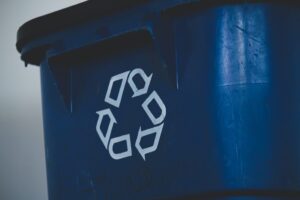Recently, an increased awareness among consumers surrounding the potential health and environmental impacts of “traditional” menstrual products has driven new public discourse in favor of more feasible, affordable, and sustainable alternatives. Examples of these products include reusable menstrual cups/disks, absorbent underwear/swimwear, reusable fabric pads, and disposable pads/tampons that are made with organic and ethically sourced ingredients such as cotton, bamboo, and/or cellulose. Disposable pads and tampons have established themselves as the norm in menstrual management throughout the past few decades. An estimated 50-86% of people who menstruate use disposable tampons while an estimated 62-73% of people who menstruate use disposable pads (Branch et al., 2015). While these products are effective at preventing the release/absorption of menstrual fluid on to one’s underwear/clothing, it is important to consider the implications of such products on individual health and environmental sustainability.

One of the main concerns surrounding the health implications of disposable pads and tampons largely relates to the lack of transparency involving the ingredients and substances that make up these products. Currently, the Food and Drug Administration (FDA) categorizes menstrual products as medical devices. Because of this categorization, the FDA can only recommend that manufacturers provide general information pertaining to the material composition of their products; they are not required to disclose a full ingredient list on the packaging (Rabin, 2017). As a result of the voluntary nature of ingredient disclosure, many consumers remain unaware to the ingredients that their bodies are being exposed to over the course of their menstruating years.
Most disposable pads and tampons are made from rayon, synthetic compounds, and/or non-organic cotton (Peberdy et al., 2019). Certain additional chemicals/substances included in the material composition of some pads and tampons that may be concerning for some individuals include dioxins and furans, chlorine, pesticide residues, and undisclosed fragrances (Made Safe, n.d.). However, it is important to note that the safety risks associated with regular disposable pad and tampon use are rare per the FDA (Rabin, 2017). Sensitivity to certain chemicals/substances found in disposable pads and tampons may vary based on the individual. For that reason, the lack of transparency from disposable pad and tampon manufacturers may be reason enough to consider alternatives that have the potential to be less irritating to people with sensitivities. For those with sensitivities, organic pads/tampons that are made with organic and ethically sourced ingredients such as cotton, bamboo, and/or cellulose may be a worthwhile alternative to those “traditional” products.
Perhaps of most significance is the environmental implications from disposable pads and tampons being a source of single-use plastic (Peberdy et al., 2019). The environmental impact of disposable menstrual products largely stems from their single-use nature. In the U.S., an estimated 12 billion pads and 7 billion tampons are discarded each year and most of these products will end up in landfills, sewers, and the ocean (Spinks, 2015). Additionally, the processing of plastics required for the creation of disposable menstrual products is highly energy-intensive when compared to the life cycle of these products. Overall, the creation of these single-use products is labor intensive and, when discarded, they may take decades to fully break down and impact local and marine ecosystems in the process. Alternatives to disposable menstrual products, such as menstrual cups/disks, absorbent underwear/swimwear, and reusable fabric pads, are more environmentally sustainable and may be more financially feasible in the long run.
Individual preferences surrounding menstrual management are highly personal and are largely influenced by one’s lifestyle, needs, culture, and financial status. For many, individual preferences may warrant the use of disposable pads and tampons. However, understanding the potential health and environmental repercussions of disposable menstrual products may allow someone the opportunity to consider alternatives that they had not considered before. Public discourse surrounding menstrual management has remained a cultural taboo that works to reinforce menstruation as a shameful, private, and unhygienic monthly occurrence, especially amongst young people. Because of this, open and honest dialogue and comprehensive menstrual education are imperative to ensuring that everyone, especially young people, have the information they need to make their own informed decisions surrounding how they will choose to manage their menstruation.

Written by: Eleanor Evins-Health Educator, Candor Health Education
References
Branch, F., Woodruff, T. J., Mitro, S. D., & Zota, A. R. (2015). Vaginal douching and racial/ethnic disparities in phthalates exposures among reproductive-aged women: National Health and Nutrition Examination Survey 2001–2004. Environmental Health, 14(1), 1-8. https://doi.org/10.1186/s12940-015-0043-6
Made Safe. (n.d.). Feminine Care. https://www.madesafe.org/education/whats-in-that/feminine-care/
Peberdy, E., Jones, A., & Green, D. (2019). A study into public awareness of the environmental impact of menstrual products and product choice. Sustainability, 11(2), 473. https://doi.org/10.3390/su11020473
Rabin, R. C. (2017, May 24). Period activists want tampon makers to disclose ingredients. The New York Times. https://www.nytimes.com/2017/05/24/well/live/period-activists-want-tampon-makers-to-disclose-ingredients.html
Spinks, R. (2015, April 27). Disposable tampons aren’t sustainable, but do women want to talk about it? The Guardian. https://www.theguardian.com/sustainable-business/2015/apr/27/disposable-tampons-arent-sustainable-but-do-women-want-to-talk-about-it
* This author, article, and Candor Health Education do not to endorse nor promote any specific product(s). This article exists as a source of information on the potential effects of disposable pads and tampons and to provide alternatives to the later.
